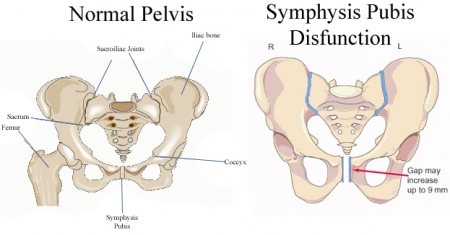Pelvic Pain (Symphysis Pubis Dysfunction): Symptoms, Causes, Treatment, Exercises
:format(webp)/cdn.mskdoctors.com/storage/2024/8/QQgkN2dNgBcTdtyxkRD9HuM17MO7PIlW.jpg)
Key Takeaways
-
If you have Symphysis Pubis Dysfunction (SPD), you may experience pain in your pelvic area, and may have trouble moving around.
-
SPD is usually caused by hormonal changes during pregnancy, physical stress, or pre-existing conditions that affect your muscles and bones.
-
Doctors usually diagnose SPD by examining you and sometimes by using imaging tests like X-rays or ultrasounds.
-
You can treat SPD with strategies to manage your pain, physical therapy, and supportive devices like sacroiliac (SI) belts, pregnancy support belts, and maternity pillows.
-
If you have SPD, you should do exercises that gently strengthen your pelvic floor muscles, core muscles, and inner thigh muscles and improve your stability. You should avoid movements that make your symptoms worse.
What Is Pelvic Pain (Symphysis Pubis Dysfunction)
Pelvic pain, or Symphysis Pubis Dysfunction (SPD), is a condition that causes discomfort and pain in your pelvic area. It is a common problem, especially during pregnancy, when the body is changing a lot. SPD happens when the ligaments that usually keep your pelvic bone aligned become too relaxed and stretchy. This causes your pelvic bone to be unstable and painful.
How SPD Affects Your Ability to Move
SPD can greatly limit your mobility because the pelvis is a key point of movement in the body. Pain in the pelvic joint can make simple tasks like walking, climbing stairs, or even turning over in bed very difficult. The level of pain and mobility problems can differ greatly from one person to another.
Causes of Pelvic Pain
The following are some causes of Pelvic Pain:
Hormones in SPD
When a woman is pregnant, her body produces a hormone called relaxin. This hormone helps to prepare the pelvis for childbirth by loosening the ligaments. However, this can sometimes cause the symphysis pubis joint to move too much, which can lead to SPD.
In addition to relaxin, other hormones such as estrogen and progesterone also surge during pregnancy and contribute to the laxity of the ligaments. This loosening of the ligaments can result in the misalignment and instability of the pelvic joint.

Physical Strain and Pressure on the Pelvis
Physical strain, like the kind that comes from carrying twins or triplets, can add extra pressure on the pelvis, increasing the likelihood of SPD. Furthermore, certain activities and jobs that require heavy lifting or a lot of movement can heighten the risk of SPD.
It's also important to remember that the position of the baby in the womb can also place pressure on the pelvis and cause pain.
Existing Skeletal and Muscular Conditions
If you've had previous injuries or conditions that affected your pelvis, hips, or spine, you may be more prone to SPD. These existing conditions can mean that your body is already compensating for weaknesses or imbalances, which can be exacerbated during pregnancy or other times of physical stress.
Symptoms of Pelvic Pain
Understanding the symptoms of SPD is the first step in receiving the proper treatment. Some of them are:
-
Experiencing sharp or stabbing pain in the pelvic area, particularly when doing activities like walking or climbing stairs
-
Struggling with movements that involve the pelvic area, such as getting in and out of a car
-
Hearing a clicking or grinding sound in the pelvic area
How to Tell the Difference Between SPD and General Pubic Discomfort
General pubic discomfort is common, especially in the later stages of pregnancy. However, SPD is characterized by more intense and specific pain that can significantly impact daily activities. It's important to pay attention to the nature of the pain and how it affects movement to differentiate between general discomfort and SPD.
When to Seek Help for Pubic Pain
If you have any of the symptoms we've mentioned, particularly if they're disrupting your daily activities, it's time to get help. Getting help early on can greatly impact how well you manage the condition and improve your life.
Don't forget, SPD is often seen in pregnancy, but it can happen at other times too. So, even if you're not pregnant and you have SPD symptoms, you should still get in touch with the healthcare professional.
How Is Pelvic Pain Diagnosed?
To diagnose SPD, a healthcare provider will conduct a comprehensive clinical evaluation. This will involve asking you about your symptoms, your medical history, and any activities that make your pain worse. They will also perform a physical examination to evaluate the stability, alignment, and pain in your pelvic area.

Medical Examination Techniques
In a typical medical examination, the doctor will press lightly on different parts of the pelvis to find out where the pain is coming from. This is called palpation of the pubic symphysis. They might also ask you to do some movements or stretches so they can see how far your pelvic joints can move and how stable they are.
Diagnostic Imaging Tests
Occasionally, imaging tests like X-rays, ultrasounds, or MRIs might be necessary to exclude other conditions and confirm an SPD diagnosis. These tests can offer in-depth images of the pelvic area's bones and soft tissues, which can help pinpoint any irregularities or measure the separation of the pubic symphysis.
Treatment for Pelvic Pain
The goal of SPD treatment is to manage pain and keep the pelvic area stable. Treatment would be comprehensive, combining medical care with self-care and changes in lifestyle.
Pain Medication and Management
The doctors might suggest over-the-counter pain relievers like acetaminophen to help manage your pain. In some instances, they might prescribe stronger medication if necessary.
Other ways to manage pain could include:
-
Using hot or cold packs on the area to help relieve pain and swelling.
-
Taking it easy and avoiding things that make it hurt.
-
Using a pelvic support belt for extra stability in the pelvic area.
Physical Therapy Treatments
Physical therapy can be a great help for those with SPD. A physical therapist can guide you through exercises that will strengthen the muscles around the pelvis without making your symptoms worse. They can also show you the right way to move and use your body to help take some of the strain off the pelvic joint.
Supportive Device Usage
Devices that provide support, such as crutches or pelvic support belts, can be beneficial in managing SPD. These devices can help to stabilize the pelvis and decrease pain during activities. The correct device and its usage can be advised by the healthcare provider.

Exercises to Manage Pubic Pain
Workouts are a key part of handling SPD. However, it's crucial to pick the correct workouts that concentrate on fortifying and stability without inflicting more pain.
Soft yet Powerful Stability Workouts
Here are some of the best exercises for SPD:
-
Do pelvic tilts to make your abdominal muscles stronger.
-
Try Kegel exercises to strengthen your pelvic floor.
-
Do Pilates or yoga that's safe for pregnant women to improve your overall strength and flexibility.
Always talk to the healthcare practitioner before you start any exercise program to make sure it's safe and right for your particular condition.
Some Don'ts
There are also certain activities you should steer clear of to keep your SPD symptoms from getting worse:
-
Steer clear of activities that make your pelvis move unevenly, like lunging or stepping over things.
-
Avoid actions that make you stand on one leg, like putting on clothes while standing up.
-
Be careful with movements that make your legs spread wide, like getting in and out of a car.
Prognosis for Pubic Pain
Most people with SPD can look forward to getting better with the right treatment. The outlook is usually good, especially if you get treatment early and stick to the treatment plan.
Temporary Relief vs. Permanent Recovery
Temporary relief is often achieved through pain management and supportive devices, while permanent recovery may involve a combination of physical therapy and changes to your lifestyle. Recovery time can vary, but most people see a significant improvement within a few weeks to months.
What to Expect During Recovery from Postpartum SPD
If you developed SPD while you were pregnant, you'll likely start to feel better after you give birth as your hormone levels go back to normal. But it's still important to keep doing any exercises or therapy that were recommended to you after you give birth to help with your recovery and to stop SPD from coming back.
Keep in mind that everyone's healing process is different. Be kind to your body and follow the medical team's advice for the best results.
-
At MSKDoctors, we have a team of experienced musculoskeletal doctors and orthopedic surgeons who can guide you through the SPD remedy.
-
We provide all the information and resources you need to make the best decisions about your care.
-
Our treatment plans are personalized to meet your unique needs and ensure the best recovery.
-
We use innovative tools like musculoskeletal motion AI to track and improve your treatment.
-
Our multidisciplinary team provides comprehensive care for your musculoskeletal health.
MSKDoctors is a platform that connects patients with the top experts in musculoskeletal health. We are here to help you take control of your musculoskeletal health by providing reliable information and access to the best care.
We know that living with conditions such as Symphysis Pubis Dysfunction (SPD) can be tough, but we're here to support you at every stage.
How MSKDoctors Can Help You Manage Pelvic Pain (Symphysis Pubis Dysfunction)
At MSKDoctors, we understand that every patient is different, and their treatment plan should reflect that. We take the time to understand your specific conditions like SPD, needs, and goals. Whether you're looking to manage pain, improve mobility, or a combination of the two, our team will create a customized treatment plan that fits with your lifestyle and helps you return to your daily activities as seamlessly as possible.
Contact us today to learn more about SPD and how we can help.
Frequently Asked Questions (FAQ)
What Changes in My Daily Life Can Help to Lessen SPD Symptoms?
SPD can be hard to live with, but there are lifestyle changes you can make that will help lessen your symptoms:
-
Refrain from activities that put extra pressure on the pelvis, such as heavy lifting or standing for long periods.
-
If you are pregnant, consider using a pregnancy support belt to provide additional support to your pelvic area.
-
Work on maintaining a healthy weight to lessen the pressure on the pelvis.
Does SPD Have Any Long-Term Complications?
For the majority of people, SPD is a temporary condition that improves with the right treatment. However, in rare instances, if SPD is not treated, it can result in chronic pain and long-term mobility problems. That's why it's so important to seek treatment promptly and to follow your healthcare provider's advice.
Can SPD Affect Future Pregnancies?
Yes, if you've had SPD in a previous pregnancy, you're more likely to have it in future pregnancies. If you're planning to have another baby, make sure you tell your healthcare provider. They can keep an eye on you and give you some preventative care if you need it.
How Does SPD Impact Your Sex Life?
SPD can make sex difficult due to the pain and discomfort it causes. It's important to communicate with your partner about what you're experiencing. You can try different positions or activities that are comfortable for both of you. If you need help, don't be afraid to ask a healthcare provider for advice.
Is it Ever Necessary to Have Surgery for SPD?
It is very uncommon to need surgery for SPD, and it is usually only an option when all other treatments have not worked. Before even thinking about surgery, it is crucial to try non-invasive treatments such as physical therapy and pain management.
:format(webp)/cdn.mskdoctors.com/storage/2025/5/ZfQ6gzRIzszsowJqOQGDJDwD3J4MbpN9.jpg)
:format(webp)/cdn.mskdoctors.com/storage/2025/5/wJNi2HzO1mX0VClrU6WeaXZQKmN5sSmZ.jpg)
:format(webp)/cdn.mskdoctors.com/storage/2025/5/PbgR15zgUrhJ98ptgUjvWRY6lFp4RBJl.jpg)
